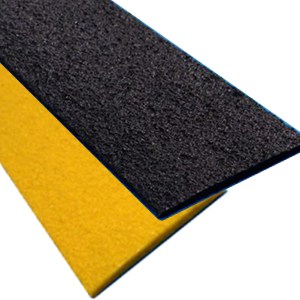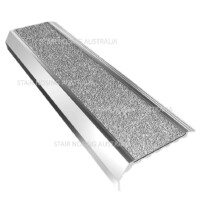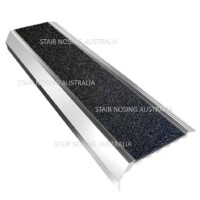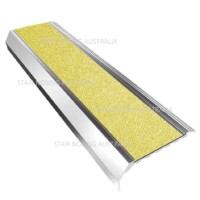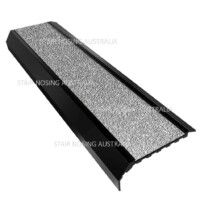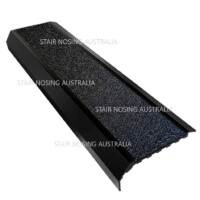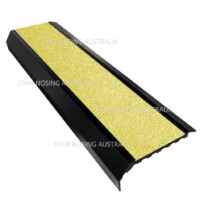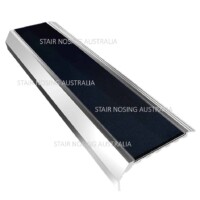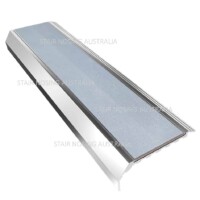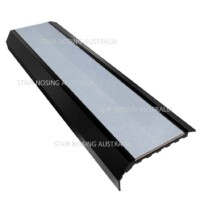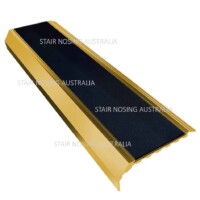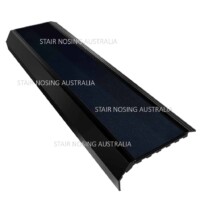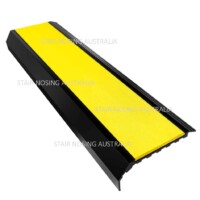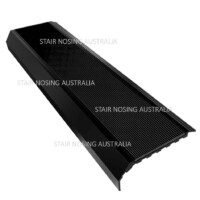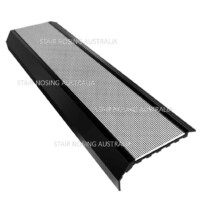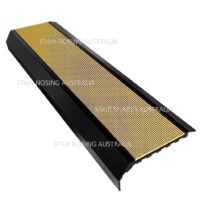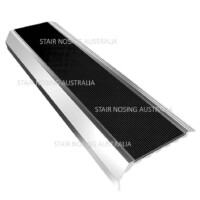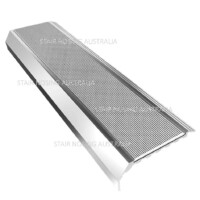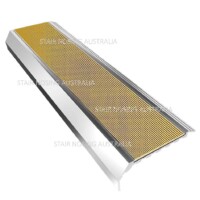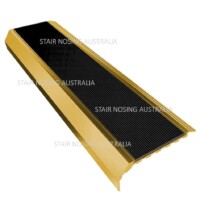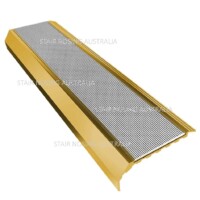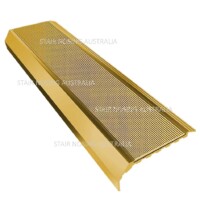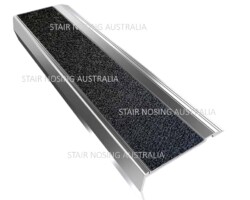Stair nosing for thick carpet
Broadloom carpet is woven on a loom, and is essentially made as a continuous broad length usually about 3.6 metres. Installing broadloom carpet on stairs is often more complex than carpet tiles due to its width,.
Stair nosing for carpet can be hard to find which makes this nosing unique
Other nosings that are suitable for thick carpet is the 10 series. The 16 series is also suitable for carpet tiles.
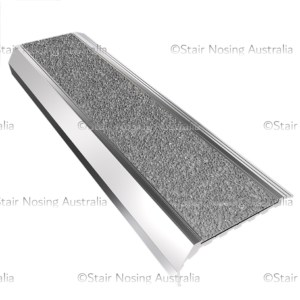
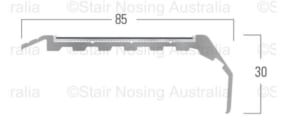
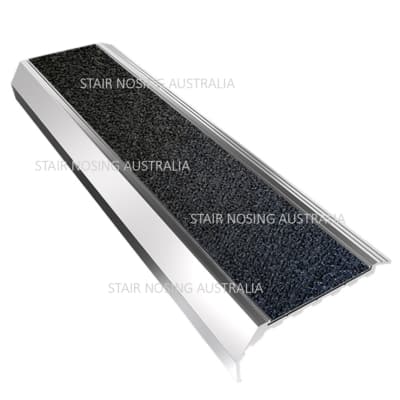
Carborundum inserts
Santoprene rubber inserts
Aluminium ripple trim inserts
ORDERING
![]() Cut to size and countersunk
Cut to size and countersunk
We will cut to size and countersink the stair nosing for you. You will not have to pay for wastage.
Additionally we will supply plugs and screws.
![]() The stair nosing can be ordered at the maximum length of 6.1 metres. TNT charge a very large fee for oversize freight and manual handling.
The stair nosing can be ordered at the maximum length of 6.1 metres. TNT charge a very large fee for oversize freight and manual handling.
HINT!
If you are not sure about the exact measurements, average the lengths giving yourself a margin for error. You may them choose to cut them to the exact width onsite.
INSTALLATION
For mechanical fixings we recommend 12-gauge stainless steel screws suitable for countersinking. SUPPLIED WITH PLUGS AND SCREWS.
This stair nosing can be installed on thick flooring finishes such as carpet.
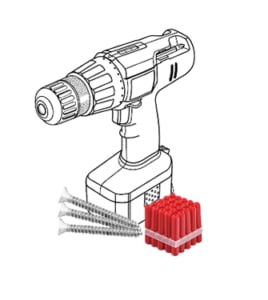 Any issues which may affect the stability or strength of the stair nosing must be addressed and corrected prior to installing any stair nosing profile. This nosing is a SCREW FIX ONLY.
Any issues which may affect the stability or strength of the stair nosing must be addressed and corrected prior to installing any stair nosing profile. This nosing is a SCREW FIX ONLY.
Drill Bit sizes
- Pilot hole 2 mm drill bit
- 4.5 mm drill but for red plugs
- 6 mm for green plugs
What do we mean by substrate?
A substrate is the surface on which you will be installing the stair nosing. This is important as it will enable you to choose the correct stair nosing. It is also important in determining how you will install the stair nosing. Some stair nosing can be installed using a very strong adhesive such as T-Rex or High Tack Fix All by Soudal. Many stair nosings can be mechanically fixed; meaning you can drill, plug and screw. If you are installing onto wood, then all you need to do is use wood screws.
What do we mean by "surface" mount stair nosings
Surface mount stair nosings mean that sit on top of the step and the back of the nosing or rakes back and diminishes. Surface mount stair nosing are suitable for all surfaces. On soft flooring finishes such as carpet, many there are products which can be a "flush" finish. This means that the stair nosing sits flat on the step edge.
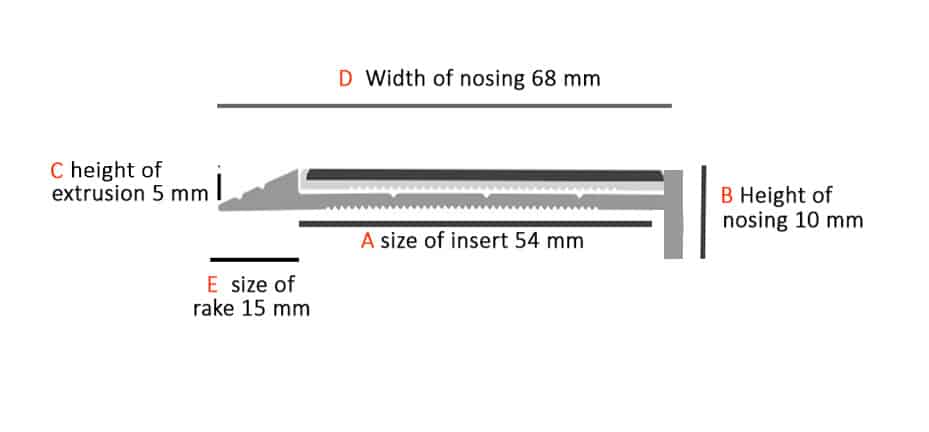
What do we mean when we say that the stair nosing is "flush mount"?
A flush mount stair nosing is a stair nosing that sites flush with the step, or it sits flat on the step. Most of the stair nosing that sit flush or flat on the top of the step are generally recessed into substrates or floor finishes. Many clients do not want a surface mount stair nosing where it rakes back, but would rather a stair nosing that6 sits flat on the step. Commonly these substrates may include ceramic tiles, concrete or wood. Generally hard surfaces. Stair nosing designed for carpet tiles, vinyl or thick carpet will also be installed flush mounted. It is purely the preference of the builder.
Which nosings can I install just using adhesive, or do I have to mechanically fix?
All of our stair nosings can be installed using adhesive only. There are several important points to note though.
-
-
-
Ceramics. The substrate (concrete, tiles, wood) must be level and free from defects. Defects are very chipped edges, dirt, grease and free of water.
-
Bricks and Pavers. In the case where we have installed stair nosing onto hard surfaces, such as brick or pavers, we always drill, plug and screw. Bricks or pavers often have chipped edges have mortar joins and for this reason we drill, plug and screw.
-
Concrete. You can drill, plug and screw (mechanically fix) or use adhesive or both. We tend to drill, plug and screw. If the steps are in great condition and are level, we would use adhesive.
-
Steel-Checker plate. Steel can be hard to drill through, especially if it is thicker than 3.5mm. You can use self tapping screws using the countersunk holes as a guide. If it is over 3.5 mm thick, we recommend using T-Rex by Soudal.
-
Soft floor finishes-Carpet must be mechanically fixed; that means drilled, plugged and screwed.
-
Limestone-Limestone can be very soft and porous. We would assess the steps and determine if it would be best too mechanically fix or adhesive fix. On some occasions we have wanted to drill, plug and screw but have discovered that even when we drill a pilot hole, the limestone starts to crumble. We definitely would then use T-Rex.
-
Wood. Wood is the easiest of surfaces. Using the pre-drilled holes, you can drill a pilot hole and then screw the nosing directly into the steps using a wood screw.
-
-
When you purchase Soudal, it is important to know that one tube applied in a snake like fashion on the back of the stair nosing, will do about 8 lineal metres of stair nosing
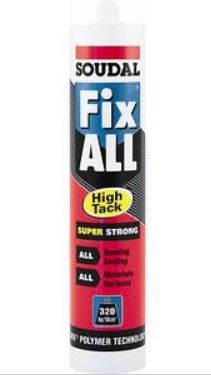
![]()
Where can I buy the recommended adhesive?
Stair Nosing Australia are a distributor of the Soudal Adhesive range. We will discuss with you the best method of install and if required we can supply you with the adhesive. We have plenty of "How To" videos.?When you purchase Soudal, it is important to know that one tube applied in a snake like fashion on the back of the stair nosing, will do about 8 lineal metres of stair nosing.
Are you installing the stair nosing onto wood steps?
Wood is the easiest of surfaces to install stair nosing. Using the pre-drilled holes as shown in the picture, you can make a pilot hole with a 3mm or 4 mm drill bit and then using an 8 mm wood screw. Use the drill and screw the nosing directly into the steps. Once you have done that, remove the red double sided tape, and then place the insert into the rebate.
Are you installing the stair nosing onto hard surfaces such as ceramics?
All of our stair nosings can be installed using adhesive or they can be mechanically fixed. There are several important points to note though.
-
Ceramics. The substrate (concrete, tiles, wood) must be level and free from defects. Defects are very chipped edges, dirt etc.
-
With ceramic tiles or terrazzo or porcelain some installers are reluctant to drill, plug and screw, as the tiles may crack. If you use the right drill bits you can achieve this. In 90% of the cases we use adhesive. The adhesive we use is Soudal Fix-All Hi Tack, or Soudal T-Rex. With the correct application the stair nosing will not come up. We have had situations where the honed aggregate, or ceramic tiled steps have a lot of pooled water on them. In this case we would drill plug and screw. We have plenty of videos on how to install stair nosing on different substrates.
When you purchase Soudal, it is important to know that one tube applied in a snake like fashion on the back of the stair nosing, will do about 8 lineal metres of stair nosing.
Are you installing the stair nosing onto bricks or pavers?
In the case where we have installed stair nosing onto hard surfaces, such as brick or pavers, we always drill, plug and screw. Bricks or pavers often have chipped edges and may have mortar joins and for this reason we drill, plug and screw. Additionally we may also use adhesive.
Are you installing the stair nosing onto concrete steps?
You can drill, plug and screw (mechanically fix) or use adhesive or both. We tend to drill, plug and screw. If the steps are in great condition and are level, we could use adhesive. When you purchase Soudal, it is important to know that one tube applied in a snake like fashion on the back of the stair nosing, will do about 8 lineal metres of stair nosing.
Are you installing the stair nosing onto steel or checker plate?
Steel-Checker plate. Steel can be very hard to drill through, especially if it is thicker than 3.5mm. You can use high strength self tapping screws, and use the countersunk holes in the stair nosing as a guide. If the steel is over 3.5 mm thick, we would recommend using T-Rex by Soudal. When you purchase Soudal, it is important to know that one tube applied in a snake like fashion on the back of the stair nosing, will do about 8 lineal metres of stair nosing.
Are you installing the stair nosing onto soft floor finishes such as carpet?
Soft floor finishes such as carpet must be mechanically fixed; that means drilled, plugged and screwed.
Are you installing the stair nosing onto limestone steps?
Limestone can be very soft and porous. We would assess the steps and determine if it would be best to mechanically fix, or to do an adhesive fix. On some occasions we have wanted to drill, plug and screw but have discovered that even when we drill a pilot hole, the limestone starts to crumble. We would then use Soudal T-Rex or Soudal Hi-Tack Fix All Adhesive. 
 When you purchase Soudal, it is important to know that one tube applied in a snake like fashion on the back of the stair nosing, will do about 8 lineal metres of stair nosing.
When you purchase Soudal, it is important to know that one tube applied in a snake like fashion on the back of the stair nosing, will do about 8 lineal metres of stair nosing.
What is a stair strip?
Some people get confused over the terms a stair nosing and a stair strip. A stair nosing has a "nose" on it which comes down the face or riser of the step. A stair strip is generally a non slip strip that sits on top of the step. There are rules with installing both. With a stair strip it must be larger than 50mm wide, and it cannot be set back more than 15 mm from the step edge.
